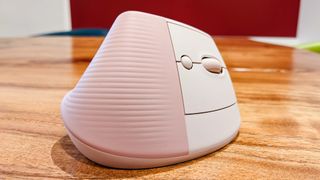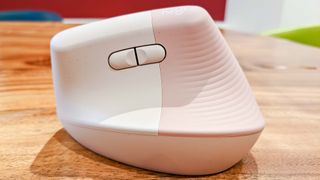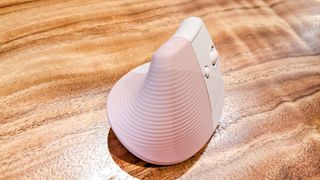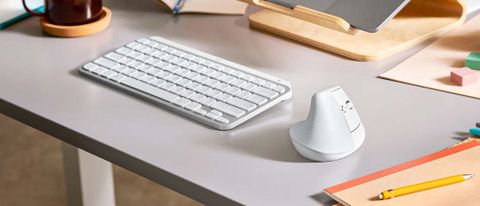Tom's Guide Verdict
The Logitech Lift is smaller and lighter than Logitech’s previous vertical mouse, although the design is still an acquired taste.
Pros
- +
Unconventional design
- +
Long battery life
- +
Cool range of colors
Cons
- -
May not alleviate wrist pain
- -
Not rechargeable
- -
Software still has a few kinks
Why you can trust Tom's Guide
Price: $69.99
Max DPI: 4,000
Buttons: Six
Size: 4.3 x 2.8 x 2.7 inches
Weight: 4.4 ounces
The second you get your hands on the Logitech Lift mouse, you'll probably know whether you love it or hate it. Like the Logitech MX Vertical, the Lift turns the standard mouse design completely on its head — or, more accurately, on its side. When you use this peripheral, you'll hold it more like a coffee cup than a traditional mouse, with your hand rotated at a 90-degree angle. Depending on your preferences, that will either be thrilling, or inconvenient.
Once you get past the Lift's unconventional design, there's still a lot to like. Like most Logitech mice, the Lift is rich with features, from its helpful extra buttons, to its easily switchable profiles. The device boasts an incredibly long battery life, and comes in a few interesting color combinations. At $70, it's also a bit cheaper than Logitech's other high-end productivity mice.
On the other hand, the Lift runs on imperfect software, and may simply relocate wrist pain, rather than eradicate it. Read on for our full Logitech Lift review.
Logitech Lift review: Design
The first thing you'll notice about the Logitech Lift is that it's not shaped like a traditional mouse. Instead, the Lift is what's known as a "vertical mouse," which is essentially what you'd get if you turned a regular mouse on its side. This means that the majority of the Lift's buttons are on its right side, and that you'll hold it with a completely different grip.
Generally speaking, vertical mice can be beneficial for users with carpal tunnel and similar wrist problems, since these peripherals don't put much pressure on the carpal ligament. It's worth noting that Logitech doesn't make any medical claims about the Lift, however, nor is an ergonomic mouse guaranteed to alleviate any symptoms.

Once you get past the Lift's strange appearance, it has all the features that you'd expect from a high-end Logitech mouse. On the face, you'll find a right-click button, a left-click button, a clickable scroll wheel and a small circular button that, by default, lowers cursor speed. (You can program it to do whatever you want, though.) On the left side of the mouse, there are two programmable thumb buttons. Underneath, you'll find a profile-switching button, a power button and the battery compartment, which fits a single AA battery and a wireless USB dongle.

It's worth noting that the Lift comes in three color schemes: Pale Grey (white and off-white), Graphite (black and gray) and Rose (pink and, well, pink). Productivity gear is often all black, all the time, so it's good to see a little variety in this department.
Logitech Lift review: Features
More than anything else, the Logitech Lift's unusual design sets it apart from other productivity mice. While we've seen this profile before in the MX Vertical, the MX Vertical was also a much bigger mouse. Vertical mice are simply not that common, and that's doubly true for "vertical mice that are also high-end productivity peripherals." If you want a small-to-medium vertical mouse from a major manufacturer with a lot of software features, the Lift may well be your only option.

The Lift does have a few other interesting features if you're willing to do some legwork, however. First and foremost, there's the "easy-switch" functionality, which is present on most of Logitech's premium productivity mice. You can connect the Lift with up to three different devices simultaneously — a desktop, a laptop and a tablet, for example. The device offers both Bluetooth and USB wireless functionality, so this is relatively easy to do. Then, when you want to switch among devices, you simply press a button on the bottom of the mouse. It's a smart, effortless feature, and it has tangible benefits for users with multiple machines.
Logitech Lift review: Logi Options+ software
It's also worth discussing the Logi Options+ software here, as that's how you'll control a lot of the Lift's optional features. This software is still in beta, but you can still accomplish everything that the older program, Logi Options, let you do. You can adjust the dots-per-inch (DPI) sensitivity, although Options+ just calls this "pointer speed," and uses percentages rather than actual numbers. This is a blow for power users, although maybe it's more comprehensible for newbies.
Options+ also lets you reprogram buttons, although the feature is hit-or-miss. If you want to prepare a profile from scratch, you have a ton of options for each button, from launching applications to panning left and right through a document. However, Options+ can also set up automatic profiles, which don't always download properly. Since it's beta software, users will have to wait for a patch, or else program profiles themselves.

Finally, Options+ lets you activate Flow, which lets you scroll seamlessly across multiple computer screens, and even drag and drop files. This is handy if you have a desktop and a laptop side-by-side, although it's not a make-or-break feature otherwise.
Logitech Lift review: Performance
I used the Lift as my regular mouse for the better part of a workweek, and I came away with mixed feelings. In spite of its unusual design, the Lift is still remarkably intuitive and easy to use. Once I got used to holding my hand sideways, I was able to browse the Web, type up Word documents, listen to music, communicate on Slack and just generally navigate through Windows as I normally would. The Lift is a competent productivity mouse with some handy extra features.

On the other hand, I encountered the same problem with the Lift as I did with the MX Vertical: a single point of pressure on my wrist. The Lift didn't put any pressure on the bottom of my wrist, but there was still a single point of contact between the side of my wrist and my mouse pad. As such, using the Lift still caused discomfort over time, just in a different spot than I was used to. There was no "learning curve" to holding the mouse differently; this is just the position to which I always gravitated.

I asked a Logitech representative about this, and he explained that just as a regular mouse isn't comfortable for everyone, neither is a vertical mouse. The purpose of the Lift isn't to be a panacea for everyone who's ever experienced wrist pain; it's simply another option worth exploring. As such, I'd highly recommend that you try to get your hands on the Lift, or a comparable vertical mouse, before you invest $70 in it.
Logitech Lift review: Battery life
The battery on the Lift is a bit of a double-edged sword. Logitech advertises that the Lift can last up to 24 months on a single charge, although the company doesn't specify exactly what conditions would facilitate that. I can say that in my own testing, the charge didn't drop below 100% after a few days of sustained office use. Supposing the mouse loses about 1% of charge per week, that would indeed put it in line with Logitech's estimate.
On the other hand, having to replace batteries in a premium mouse feels a little bit outdated and wasteful. Many mice in this price range, including Logitech's own MX Anywhere 3, offer rechargeable batteries.
Logitech Lift review: Verdict
The Logitech Lift has an idiosyncratic design, which may not work for everyone. It has a few software issues to iron out, and a rechargeable battery would have been nice. Still, the Lift has an awful lot to like. From its striking design to its excellent performance to its handy extra features, the Lift is a worthwhile accessory for hardcore productivity and general computing alike.
Users with bigger hands will probably want the MX Vertical instead, while more traditional mouse fans may be better off with the Logitech MX Master 3. Otherwise, give the Lift a look if you've got small hands and/or wrist problems. Be sure to look at our Logitech promo codes page to see if we can save you a little extra on the price too.
Marshall Honorof is a senior editor for Tom's Guide, overseeing the site's coverage of gaming hardware and software. He comes from a science writing background, having studied paleomammalogy, biological anthropology, and the history of science and technology. After hours, you can find him practicing taekwondo or doing deep dives on classic sci-fi.

